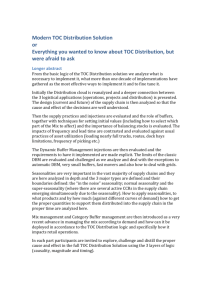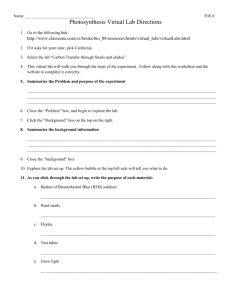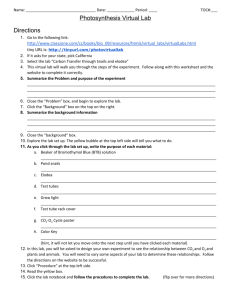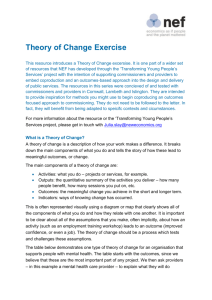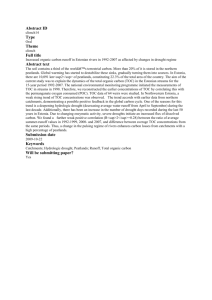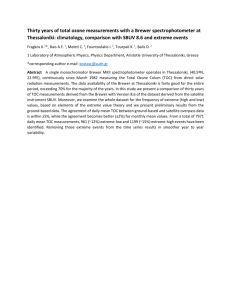Evaluating REACH Foundation Funded Projects
advertisement
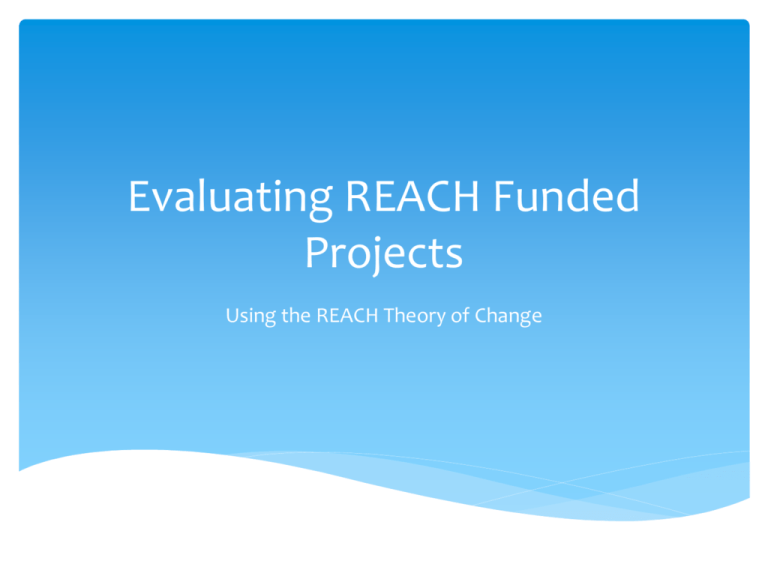
Evaluating REACH Funded Projects Using the REACH Theory of Change What is Evaluation? Evaluation is a systematic* method for collecting, analyzing, and using information to answer basic questions about a program Why does the Foundation ask that you include evaluation in your proposal? Help you tease out why a program works or doesn’t and under what conditions Establishes an evidence-base that we all want and need Improves your staff’s practice with patients, clients or consumers Show how patients, clients or consumers benefit from the program Helps the Foundation determine which strategies to continue to invest in Types of Evaluations Hundreds of different types of evaluations; two most common are: Implementation evaluation assesses whether a program was implemented as planned, whether the intended target population was reached, and the major challenges and successful strategies associated with program implementation Outcome evaluation determines whether, and to what extent, the expected changes in health outcomes occur (also called Impact) and whether these changes can be attributed to the program. How does Evaluation relate to REACH’s Theory of Change? REACH’s TOC provides guidance on where to focus your evaluation and what to measure REACH’s evaluation requirements for your grant ask you to focus your evaluation on key elements of the TOC: Impact (the change in patient health outcomes) Outcomes (the change in access or quality) Implementation (aka – Measures of Execution) REACH Healthcare Foundation’s Framework for Investments and Evaluation What is theory of change? Why we use a Theory of Change Approach REACH Theory of Change TOC is the Foundation’s roadmap that visually shows how we think our work will lead to our desired impact TOC is a representation of the Board approved strategic plan and is informed by published evidence, staff experience, and advice from experts in the field TOC defines the key building blocks required to bring about a given long-term impact. This set of connected building blocks - impacts, outcomes, strategies, barriers is depicted on a map known as a pathway of change/change framework Theory of Change A good TOC tells you. . . what impacts we seek through our investments in your work what outcomes are necessary to attain the desired impact, and which strategies are theorized to bring about positive change in outcomes Theory of Change Five components of REACH’s TOC: Expected Impact of your work Expected Outcome of your work Evidence-Based or Promising Strategies Barriers – What we seek to break through Indicators (on page 2 of TOC) general description of the kinds of changes we desire in outcomes and impact (From Simple to the Absurdly Complex) Examples of Theory of Change Communities for Teaching Excellence Legacy LA Empowers youth to become leaders in their lives and their communities Accountability Lab Involving Parents in their Child’s Education – Theory of Change TIG Theory of Change 2010 Improving Supply Chains for Community Care Management of Chronic Diseases Indicators A deeper dive into the components of the Theory Digging into the REACH Theory of Change Reading the Theory of Change Definitions Key Terms Impact – The desired change in health outcomes in the target population Outcome – The necessary theorized precursors to change in health outcomes – in the REACH TOC we believe that increasing access and improving the quality of services for our target population will lead to our desired impact Indicator – Indicators tell us how success will be recognized. In the REACH TOC indicators represent a category of potential metrics Metric – The specific behavior, condition, or status that will be measured – Metrics must be operational. By operational we mean that they include enough detail for us to be able to measure it Digging In: Long-Term Impact The desired change in health outcomes in the target population What our investments are designed to accomplish Two impacts we seek: improving health outcomes and achieving equity in outcomes, access and quality Grantees asked to select one or more Impacts may take years to accomplish Incremental improvements are expected though Measuring your Impact - Indicators REACH asks grantees to select an indicator and describe one or more metrics to measure the impact of their project on patient health outcomes The indicators in the TOC represent broad categories of specific metrics you could choose Very often the metrics you choose are ones you are already using Digging into Outcomes Early or intermediate outcome – can be achieved within a few years The measurable change in the health care provider organization and larger health care system – precursors to impact Focus is on two outcomes: increasing access to high quality services or improving quality of the services delivered – must chose at least 1 Measuring your Outcomes Indicators REACH asks grantees to measure the change in the outcomes of their project in terms of patient access and/or the quality of services patients receive. The indicators in the TOC represent broad categories of specific metrics – you must select at least 1 indicator and propose at least one metric Very often the metrics you choose to measure are ones you are already using Our focus so far – What you measure as a condition of REACH grant Outcomes Evaluation Digging into Strategies Strategies are what you have proposed to implement (and what we fund you to do) Their presence in the TOC indicates that they have an evidence-base or are promising as a practice to bring about change in the outcomes Two kinds of strategies: those that will increase access to care and those that will improve the quality of care received Measuring Strategy Implementation Strategies require execution – how well your organization executes the strategy is the focus of implementation evaluation More extensive evaluations of specific strategies will have identified implementation benchmarks and quality thresholds or standards REACH has not imposed a rigorous implementation evaluation requirement – instead, we ask that you document implementation by answering a series of key questions – Measures of Execution Measures of Execution 1. Did you do what you said you would do? Any modifications? 2. What are your standards of quality and did you meet them? 3. Is project on pace to be successfully implemented? 4. Were the right patients recruited? (Screening Criteria) 5. Were your clients satisfied with the services received? 6. Did your partners/collaborators perform as expected? Looking at the Proposal Template for Program Grants Preparing the Evaluation Section of your Program Proposal Your Plan to Measure Impact Impact (from REACH Theory of Change): The impact this project will have on the patients served is: Improve health outcomes for uninsured and medically underserved people. Indicator of Long-Term Impact 1. Improvements in health outcomes associated with chronic diseases (please specify: hypertension) Sample Metric 120 adult uninsured SBP/DBP Hispanic males seen in clinic with other diagnoses and suspected hypertension Baseline Target Goal 10% have SBP < 140 mm Hg and/or DBP < 70 mm Hg 90% will have SBP < 140 mm Hg or DBP < 90 mm Hg Your Plan to Measure Outcomes REACH Outcome (from REACH Theory of Change): The outcome of this project is: Improved quality of health care services The REACH strategy this project will implement to achieve this outcome is: Care coordination and/or intensive case management/disease management (for hypertensive adult males). Outcome Indicator 1. Increase in patient knowledge, satisfaction and/or engagement in health care decisions Sample and Metric % of 120 adult uninsured Hispanic male participating in the care coordination project. Metric: patient knowledge, satisfaction and/or engagement in care decisions Baseline 22% knowledgeable 18% satisfied 6% engaged Target Goal and Timeframe By the end of the grant term 90% will report feeling knowledgeable, satisfied, and engaged Source of Data Patient Satisfaction Survey administered at entry into the project and within 2 weeks of conclusion of the grant term How REACH evaluates our Investments Evaluation of the REACH Theory of Change How REACH evaluates our Theory of Change REACH requests and aggregates data from our grantees and partners on these measures of the components of the theory of change in order to: Test the fidelity of the theory of change; and track whether change in the inputs is indeed leading to change "downstream" in the outcomes and impacts. Where investments in specific strategies fail to bring about threshold levels (meaningful) of change in outcomes after a sustained period of investment we ask ourselves six questions: Questions REACH Asks When No Meaningful Change in Impact or Outcomes is Found 1) Is the organization implementing the strategy the right organization? 2) Was the selected strategy the right strategy to address the needs of the target population? 3) Was the strategy implemented with fidelity and consistency over sufficient time to allow for change to occur? Questions REACH Asks When No Meaningful Change in Impact or Outcomes is Found 4) Were the size and duration of the investment sufficient to allow change in outcomes and impact to occur? 5) Were the processes used by the grantee to create the conditions and capacity necessary to implement the strategy successful? 6) Were the pre-existing conditions or influences in the organization, project, and/or community considered and addressed by the grantee such that negative influences were suppressed to allow for the potential effects of the strategy to be realized?

